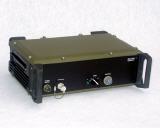Prelistaj ovo mozda dobjes jasniju sliku. http://www.fas.org/i...ct/uas-vuln.pdf
THE VULNERABILITIES OF UNMANNED AIRCRAFT SYSTEM COMMON DATA LINKS TO ELECTRONIC ATTACK
A thesis presented to the Faculty of the U.S. Army Command and General Staff College in partial fulfillment of the requirements for the
degree
MASTER OF MILITARY ART AND SCIENCE
General Studies
2010-01
Kako se ometaju data linkovi:
Sustina:
Their dependence on a constant control signal has contributed to a UAS accident rate 100 times greater than manned aircraft A threat could exploit this need for an uninterrupted data feed by using Electronic Warfare to disrupt this signal, potentially crippling unmanned systems.
Cilj:
The goal of noise jamming is to send a threat signal sufficient strength to “out shout” the transmitter sending the attacked frequency (Schlesinger 1961, 13). Noisejamming disrupts the communication waveform by inserting noise onto the receiver. The bandwidth of the signal may be as wide as the entire spectrum used by the communications system or it may occupy only a single channel
Tehnike:
Broadband jamming is also known as full band or barrage jamming. This type of jamming can be effective against all forms of anti-jamming (AJ) communication systems (Poisel 2003, 216). This type of jamming raises the background noise level at the receiver, creating a higher noise environment for an AJ system. If the noise is increased, it makes it difficult for a communications system to operate. Effective noise jamming may reduce the range of the communications or if the noise is sufficient, the jammer may deny communication (Poisel 2003, 216). An effective noise jamming attack can disrupt UAS CDL communications and cause the UAS to execute its lost link programming.
The greatest advantage of broadband noise jamming is the simplicity of the system. A jammer operator selects a frequency band and creates as much noise as possible to degrade an entire frequency spectrum. It does not require a smart means to acquire the specific transmitting frequency or the need to chase a frequency hopping system. The greatest disadvantage of broadband noise jamming is the strength of the jamming signal. The larger the spectrum being jammed, the less power is available to create noise.
Sweep jamming, or swept jamming, occurs when narrowband noise is swept across afrequency band of interest (Poisel 2003, 235). The jammer focuses on a specific frequency and a small portion of the band around the single frequency. This sweep can jam a selected band in rapid succession and have effects similar to a barrage jammer. However, a swept jammer concentrates its full power against specific frequencies on theband of interest and this allows swept jammers to have greater range than broadband jammers.
The greatest advantage of swept jamming is the ability to jam a broadband while maintaining adequate power to project its signal (Vakin, Shustov, and Dunwell 2001). Timing is the key to effective sweep jamming and if timing is correct, the jammer can hop around a spectrum with sufficient power to degrade communications. Timing is also the greatest disadvantage to swept jamming. If the jammer hops the spectrum too quickly, it may not loiter on a selected frequency long enough to achieve the degradation desired (Poisel 2003, 235).
Spot jamming, or single tone jamming, occurs when a jammer concentrates all of its power on a single frequency (Poisel 2003, 229). These jammers are effective against communications systems that do not hop and are in use by the opposition. Spot jamming does not move along the frequency spectrum and this limits the utility of such jammers against modern military equipment.
The greatest advantage of spot jamming is the power available to project on its disrupting power at a target. These jammers may have greater range than systems that attack a broad frequency spectrum (Vakin, Shustov, and Dunwell 2001). The greatest disadvantage of spot jamming is its inability to target modern frequency hopping communications and the intelligence requirement of identifying the specific target frequency (Poisel 2003, 230).
...
Man-Portable UAS are the systems most likely to experience an EA against their CDLs. These systems operate at low altitudes and in close proximity to threat forces. Their flight profile allows enemy forces to visually or acoustically acquire and track thesystem throughout their mission. Man-Portable UAS CDLs communicate on an L-band UHF frequency that is easy to jam (Poisel 2003, 213). The CDL does not use any electronic protection (EP) such as a frequency hopping radio or a coded receiver. Lastly, the UAS uses an omnidirectional that can receive commands from any direction throughout its flight profile. The C-IED devices in Iraq and Afghanistan use this type of jammer and their tendency to jam UAS CDLs is a testament to the vulnerabilities of these systems (Gaub 2010).
Tactical UAS are less likely to experience an EA against their CDLs but it is still at greater risk than Theater UAS. These systems operational altitudes are higher than Man-Portable UAS but are often within audio or visual range of threat forces (Hill 2010). Directing a jamming signal able to disrupt Tactical UAS CDLs would likely require an advanced directional antenna in order to project and focus its signal (Wilson 2010). Tactical UAS Man-Portable UAS CDLs operates using S-band UHF/SHF frequency and although more jam resistant than the L-band, it is still vulnerable to jamming (Poisel 2003, 214). Lastly, the UA uses an omnidirectional that can receive commands from any direction throughout its flight profile but the GCS transmits its signal using a directional antenna (Hill 2010)
If a CDL experiences frequency interference, the system executes a self-recovery program known as a “lost link procedure” and attempts to reacquire the CDL from the GCS. If a Man-Portable UAS fails to reacquire its CDL, it continues its self-recovery program and attempts to return to a preprogrammed recovery point. If a Tactical UAS fails to reacquire its CDL, the operators may identify the UA as rogue and deploy the systems recovery parachute to avoid endangering manned aircraft.
Edited by ravnicar, 10 August 2013 - 20:28.











